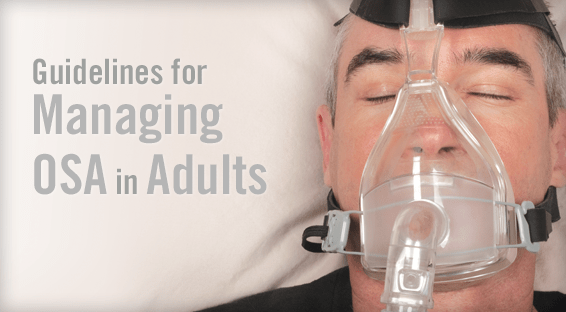Obstructive sleep apnea (OSA) is a common disorder that affects patients of all ages, especially those who are middle-aged and elderly. “Studies show that OSA rates are increasing in the United States, most likely because of rising obesity rates,” says Molly Cooke, MD. “Further complicating matters is that OSA is often misdiagnosed because its symptoms are not always specific to the disease.”
In late 2013, the American College of Physicians (ACP) published guidelines in Annals of Internal Medicine that presented evidence and provided clinical recommendations on the management of OSA in adults. Using studies from 1966 to 2012, the ACP assessed several treatments that are designed to alleviate airway obstruction during sleep. “Our purpose was to present information on OSA interventions in order to determine the net benefits of these treatments,” says Dr. Cooke, who was on the ACP writing committee. She adds that the target audience for the guidelines includes all clinicians, and the target patient population comprises all adults with OSA.
3 Key Recommendations for Obstructive Sleep Apnea
The ACP guidelines make three recommendations for treating OSA in adults (Table 1), and Dr. Cooke says the first line of defense should be weight loss. “Obesity is a risk factor for OSA,” she says. “All overweight and obese patients who have OSA should be encouraged to lose weight.” The evidence shows that some intensive weight-loss programs may effectively reduce signs and symptoms in obese patients with or without diabetes. Those signs and symptoms can include the apnea-hypopnea index (AHI), daytime sleepiness, and oxygen saturation. Weight loss is also associated with many health benefits other than for OSA.
If more treatment is needed, ACP recommends using continuous positive airway pressure (CPAP) devices as the standard first-line OSA treatment and notes that dental or mandibular advancement devices (MADs) can be used as an alternative therapy. “In cases in which patients are not overweight or weight-loss interventions fail, the next line of defense should be CPAP,” says Dr. Cooke. “CPAP is the most intensely studied therapy for OSA, and the evidence shows that it reduces daytime sleepiness, decreases AHI and arousal index scores, and increases quality of life.” The guidelines add that there is currently insufficient evidence on the effect of CPAP on cardiovascular disease, hypertension, and type 2 diabetes.
CPAP Adherence Issues Among Patients
According to Dr. Cooke, many patients do not tolerate CPAP well and often fail to adhere to instructions for using these devices for many reasons. “Discomfort with CPAP devices, skin irritation, noise, and claustrophobia are cited as common complaints,” she says. “To improve adherence, many technological modifications have been made to CPAP devices.” Most of these modifications alter how air pressure is delivered, but little is known about the utility of these modified devices. With adherence often being an issue in OSA treatment, it is likely that additional patient education or interventions will be necessary for many individuals.
MADs move the lower jaw from falling back into the throat to help prevent apnea. Evidence shows these devices are better than no treatment for improving AHI scores, arousal index scores, and minimum oxygen saturation. According to Dr. Cooke, many patients prefer MADs to CPAP. “While patients tend to prefer MADs, these devices are not as effective at correcting OSA,” she says. “These devices are best used in people who are unable or unwilling to use CPAP devices.”
Alternative therapeutic strategies for OSA include surgical interventions to remove obstructive tissue, positional therapy, pharmacologic treatment, and weight-loss interventions for obese patients. The ACP notes that although drug therapy has been tried with a range of medications, the evidence was insufficient to conclude that any of these therapies were effective. There was also insufficient evidence suggesting that surgery has any benefit, Dr. Cooke says. Given its risks and the fact that outcomes have been inconsistent, surgery is not recommended for use as initial treatment.
Improving Adherence & Enhancing Care
ACP encourages clinicians to improve care by targeting the evaluation and treatment of OSA to patients with unexplained daytime sleepiness. Dr. Cooke says clinicians should keep patient preferences, specific reasons for non-adherence, and costs in mind before initiating treatment (Table 2). “In the future, more and more people are likely to seek treatment for OSA,” she says. “The management of this disease is ultimately based on symptoms and severity. Efforts are needed to educate OSA patients about their risk factors and associated outcomes. In the future, new research should explore ways to improve adherence to CPAP so that we can overcome barriers to its use. Enhancing coordination of care and finding effective medications for OSA may also improve our ability to manage the disease.”



 TimH
TimH